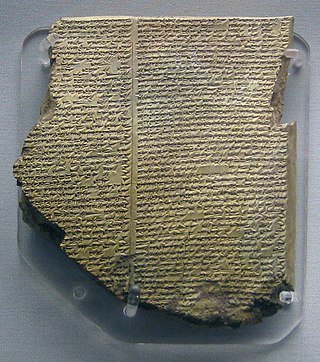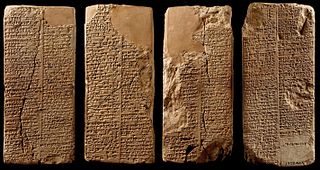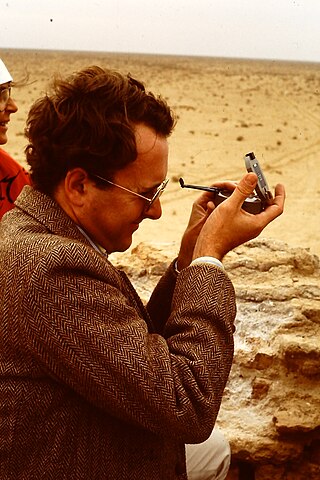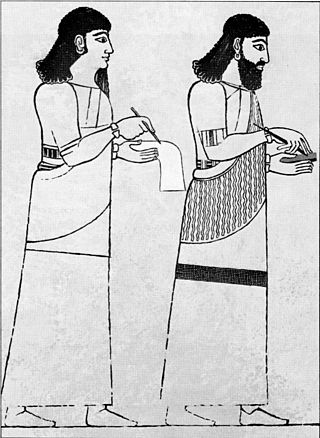Commentary or commentaries may refer to:

The Sumerian King List or Chronicle of the One Monarchy is an ancient literary composition written in Sumerian that was likely created and redacted to legitimize the claims to power of various city-states and kingdoms in southern Mesopotamia during the late third and early second millennium BC. It does so by repetitively listing Sumerian cities, the kings that ruled there, and the lengths of their reigns. Especially in the early part of the list, these reigns often span thousands of years. In the oldest known version, dated to the Ur III period but probably based on Akkadian source material, the SKL reflected a more linear transition of power from Kish, the first city to receive kingship, to Akkad. In later versions from the Old Babylonian period, the list consisted of a large number of cities between which kingship was transferred, reflecting a more cyclical view of how kingship came to a city, only to be inevitably replaced by the next. In its best-known and best-preserved version, as recorded on the Weld-Blundell Prism, the SKL begins with a number of antediluvian kings, who ruled before a flood swept over the land, after which kingship went to Kish. It ends with a dynasty from Isin, which is well-known from other contemporary sources.

The Epic of Gilgamesh is an epic from ancient Mesopotamia. The literary history of Gilgamesh begins with five Sumerian poems about Gilgamesh, king of Uruk, some of which may date back to the Third Dynasty of Ur. These independent stories were later used as source material for a combined epic in Akkadian. The first surviving version of this combined epic, known as the "Old Babylonian" version, dates back to the 18th century BC and is titled after its incipit, Shūtur eli sharrī. Only a few tablets of it have survived. The later Standard Babylonian version compiled by Sîn-lēqi-unninni dates to somewhere between the 13th to the 10th centuries BC and bears the incipit Sha naqba īmuru. Approximately two-thirds of this longer, twelve-tablet version have been recovered. Some of the best copies were discovered in the library ruins of the 7th-century BC Assyrian king Ashurbanipal.

Humbaba, originally known as Ḫuwawa in Sumerian, was a figure in Mesopotamian mythology. The origin and meaning of his name are unknown. He was portrayed as an anthropomorphic figure comparable to an ogre or giant. He is best known from Sumerian and Akkadian narratives focused on the hero Gilgamesh, including short compositions belonging to the curriculum of scribal schools, various versions of the Epic of Gilgamesh, and several Hurrian and Hittite adaptations. He is invariably portrayed as the inhabitant or guardian of the cedar forest, to which Gilgamesh ventures with his companion Enkidu. The subsequent encounter leads to the death of Humbaba, which provokes the anger of the gods. Humbaba is also attested in other works of Mesopotamian literature. Multiple depictions of him have also been identified, including combat scenes and apotropaic clay heads.

Exegesis is a critical explanation or interpretation of a text. The term is traditionally applied to the interpretation of Biblical works. In modern usage, exegesis can involve critical interpretations of virtually any text, including not just religious texts but also philosophy, literature, or virtually any other genre of writing. The phrase Biblical exegesis can be used to distinguish studies of the Bible from other critical textual explanations.

Enūma Eliš, meaning "When on High", is a Babylonian creation myth from the late 2nd millennium BCE and the only complete surviving account of ancient near eastern cosmology. It was recovered by English archaeologist Austen Henry Layard in 1849 in the ruined Library of Ashurbanipal at Nineveh. A form of the myth was first published by English Assyriologist George Smith in 1876; active research and further excavations led to near completion of the texts and improved translation.

Lugalbanda was a deified Sumerian king of Uruk who, according to various sources of Mesopotamian literature, was the father of Gilgamesh. Early sources mention his consort Ninsun and his heroic deeds in an expedition to Aratta by King Enmerkar.
Siduri, or more accurately Šiduri, is a character in the Epic of Gilgamesh. She is described as an alewife. The oldest preserved version of the composition to contain the episode involving her leaves her nameless, and in the later standard edition compiled by Sîn-lēqi-unninni her name only appears in a single line. She is named Naḫmazulel or Naḫmizulen in the preserved fragments of Hurrian and Hittite translations. It has been proposed that her name in the standard edition is derived from an epithet applied to her by the Hurrian translator, šiduri, "young woman." An alternate proposal instead connects it with the Akkadian personal name Šī-dūrī, "she is my protection." In all versions of the myth in which she appears, she offers advice to the hero, but the exact contents of the passage vary. Possible existence of Biblical and Greek reflections of the Šiduri passage is a subject of scholarly debate.

Alulim was a mythological Mesopotamian ruler, regarded as the first king ever to rule. He is known from the Sumerian King List, Ballad of Early Rulers, and other similar sources which invariably place him in Eridu and assign a reign lasting thousands of years to him. The tablet of Old Babylonian period from Ur describing the divine appointment of Alulim by the gods notes that he was chosen among "vast and many people," and appointed by gods for the "shepherdship of the entirety of the many people". Another myth describing his appointment by the gods and incantations treating him as the creator of insects are also known. He is absent from Early Dynastic sources, and he is considered fictional by Assyriologists. His name was preserved in later Greek, Arabic and Persian works.

Simo Kaarlo Antero Parpola is a Finnish Assyriologist specializing in the Neo-Assyrian Empire and Professor emeritus of Assyriology at the University of Helsinki.

Jeremy Allen Black was a British Assyriologist and Sumerologist, founder of the online Electronic Text Corpus of Sumerian Literature.

Aga commonly known as Aga of Kish, was the twenty-third and last king in the first dynasty of Kish during the Early Dynastic I period. He is listed in the Sumerian King List and many sources as the son of Enmebaragesi. The Kishite king ruled the city at its peak, probably reaching beyond the territory of Kish, including Umma and Zabala.

Wilfred George Lambert FBA was a historian and archaeologist, a specialist in Assyriology and Near Eastern Archaeology.
The Bārûtu, the “art of the diviner,” is a monumental ancient Mesopotamian compendium of the science of extispicy or sacrificial omens stretching over around a hundred cuneiform tablets which was assembled in the Neo-Assyrian/Babylonian period based upon earlier recensions. At the Assyrian court, the term extended to encompass sacrificial prayers and rituals, commentaries and organ models. The ikribu was the name of collections of incantations to accompany the extispicy. The bārûtu's extant predecessors date back to Old Babylonian times with the liver models from Mari and where the order of the exta were largely fixed.

The ancient Mesopotamian myth beginning Lugal-e ud me-lám-bi nir-ğál, also known as Ninurta's Exploits is a great epic telling of the warrior-god and god of spring thundershowers and floods, his deeds, waging war against his mountain rival á-sàg, destroying cities and crushing skulls, restoration of the flow of the river Tigris, returning from war in his “beloved barge” Ma-kar-nunta-ea and afterward judging his defeated enemies, determining the character and use of 49 stones, in 231 lines of the text. Its origins probably lie in the late third millennium BCe.

An eduba is a scribal school for the Sumerian language. The eduba was the institution that trained and educated young scribes in ancient Mesopotamia during the late third or early second millennium BCE. Most of the information known about edubas comes from cuneiform texts dating to the Old Babylonian period.

The cuneiform sign MÁ denotes a ship or boat. It is used in Sumerian and as a Sumerogram for the Akkadian word eleppu. MÁ is usually preceded by the determinative for items made of wood, namely GIŠ: GIŠ.MÁ, or GIŠ.MÁ, .
Stephanie Mary Dalley FSA is a British Assyriologist and scholar of the Ancient Near East. Prior to her retirement, she was a teaching Fellow at the Oriental Institute, Oxford. She is known for her publications of cuneiform texts and her investigation into the Hanging Gardens of Babylon, and her proposal that it was situated in Nineveh, and constructed during Sennacherib's rule.
Ninĝidru was a Mesopotamian goddess who most likely represented a deified scepter. She played a role in coronation rituals. She often appears in association with Ninmena, who represented the deified crown. A recently published hymn additionally attests that she was the sukkal of Sud, the tutelary goddess of Shuruppak.












